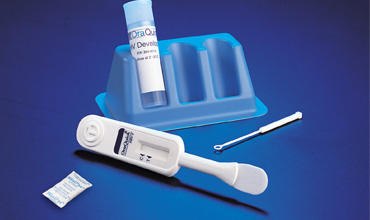Accuracy Evaluation of HIV Rapid Tests Resolved by Tie-Breaker: a Case Study of Nigerian Serial Algorithm

Abstract:
INTRODUCTION
The World Health Organization strongly recommended test
algorithm for diagnosis of Human Immunodeficiency Virus (HIV) infection. In either
parallel or serial algorithms, discordance is commonly encountered and the final
result has to be determined by the use of a tie breaker.
OBJECTIVE
The objective of this study is to evaluate the accuracy
of HIV rapid test results resolved by tie breaker in a serial algorithm using Western
Blot as gold standard.
METHODOLOGY
A
total of 110 remnant samples reactive as positive by Determine but giving discordant
result with Unigold were collected and retested by national (serial) algorithm from
January 2013 to July 2013. Samples were collected in either plain bottles or EDTA
container by staff conducting HIV rapid test and transported/stored at 2-8 degree
Celsius. Samples were tested according to manufactures leaflet insert. The final
result obtained with the serial algorithm was verified with Western Blot technique.
RESULT
Out
of the 10 discordant results, 9 were confirmed HIV positive by serial algorithm
but only 8 were confirmed positive by Western Blot technique. Thus, there was 1(11%)
false positive obtained with serial algorithm. Samples that were reactive by Determine
were 110 (100%), 94(85.5%) reactive for Unigold and 93(85%) reactive results with
Stat Pak.
CONCLUSION
One
out of every 9 HIV results resolved by tie breaker as positive is false positive.
This accounts for 11%. There is need therefore to introduce further means of verifying
positive results resolved by tie breaker to avoid placing patients on anti retro
vial drugs wrongly and subjecting people to psychological trauma.
References:
1. Aghokeng, A., et. al. (2009). “Inaccurate
Diagnosis of HIV-1 Groupe M and O is a Key Challenge for Ongoing Universal Access
to Antiretroviral Treatment and HIV Prevention in Cameroon.” PLUS One. 4.11 (2009).
Accessed on 2 November 2010. http://www.plosone.org/article/info%3Adoi%2F10.1371%2Fjournal.pone.0007702
3. Heneke, M. “An analysis of HIV-related
law in South Africa: progressive in text, unproductive in practice.” Transnational
Law & Contemporary Problems 18.3 (2009): 751. Accessed on 9 November 2010. <http://find.galegroup.com.libdb.fairfield.edu/gtx/infomark.do?&contentSet=IAC-Documents&type=retrieve&tabID=T002&prodId=AONE&docId=A211453847&source=gale&srcprod=AONE&userGroupName=a04fu&version=1.0>
4. Lihana
R.W., Ssemwanga D., Abimiku A., Ndembi N., (2012). Update on HIV 1 Diversity in
Africa: A Decade in Review. AIDS Rev 14:83-10. Available [online] at http://www.aidsreviews.com/files/2012_14_2_083-100.pdf
5. McCutchan
FE, Carr JK, Bajani M, Sanders-Buell E, Harry TO, Stoeckli TC, Robbins KE, Gashau
W, Nasidi A, Janssens W, Kalish ML. (1999). Subtype G and multiple forms of A/G
intersubtype recombinant human immunodeficiency virus type 1 in Nigeria. Virology.,
254:226-234
6.
Peeters M, Esu-Williams E, Vergne
L, Montavon C, Mulanga-Kabeya C, Harry T, Ibironke A, Lesage D, Patrel D, Delaporte
E. (2000). Predominance of subtype A and G HIV type 1 in Nigeria, with geographical
differences in their distribution. AIDS Res Hum Retroviruses. 16(4):315-25.

